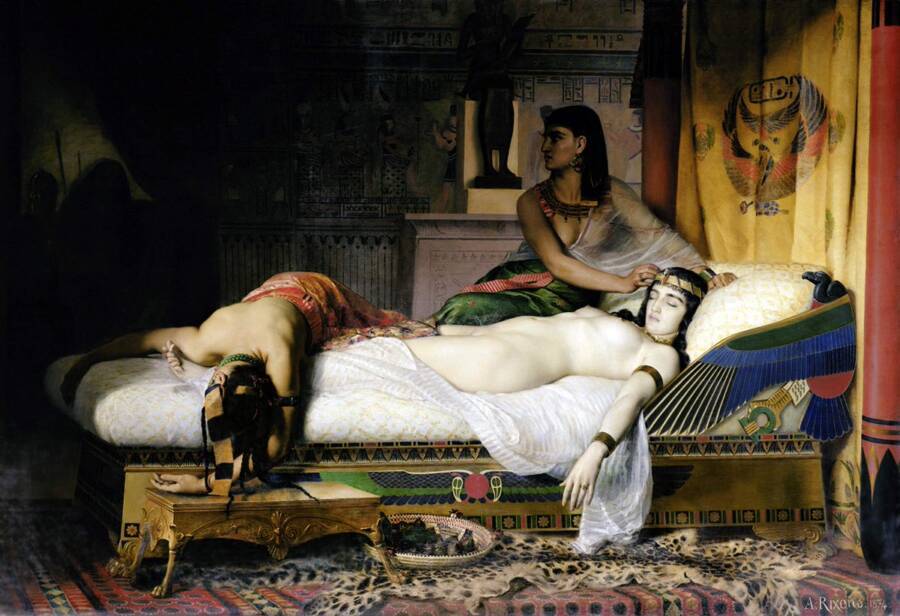Researchers may finally be close to uncovering the lost tomb of Cleopatra and Mark Antony at the Taposiris Magna temple complex near Alexandria, Egypt, where they were believed to be buried just after their suicide in 30 B.C.E.

Public DomainThe location of Cleopatra’s tomb remains fascinating more than 2,000 years after her suicide, supposedly by snake bite, according to some sources.
Cleopatra accomplished many remarkable things during her short life. But she’s most famous for her death. In 30 B.C.E., the 21-year-old Egyptian queen died by suicide in Alexandria, when it became clear that she and her lover, the politician and military leader Mark Antony, could not fend off invading Roman forces led by Octavian. But the location of their burial remained mysterious, and thousands of years later, the tantalizing search for Cleopatra’s tomb continues.
Where is Cleopatra buried? To date, no one knows for sure. It’s certainly possible that her tomb was swallowed by the ocean at some point during Alexandria’s volatile history of earthquakes, tidal waves, and rising sea levels. But it may still survive, and the exciting prospect of discovering Cleopatra’s tomb has driven archaeologists to scour Egypt for decades, with some of the latest searching taking place at the Taposiris Magna temple complex west of Alexandria.
Here’s everything we know about Cleopatra’s tomb, from what was written in antiquity to the latest theories about where it might be located.
The Short Life And Dramatic Death Of Cleopatra

Public DomainDeath of Cleopatra by Jean-Andre Rixens. 1874.
Born around 70 B.C.E., Cleopatra ruled as Egypt’s last pharaoh from 51 B.C.E. until her death in 30 B.C.E. During that time, she developed strategic — and extremely close — relationships with powerful men in Rome.
In 48 B.C.E., she met Julius Caesar, who helped her win control of the Egyptian throne from her younger brother, Ptolemy XIII. Caesar and Cleopatra, known for her beauty, enjoyed a years-long love affair and had a son together, Caesarion. When Caesar was assassinated in 44 B.C.E., Cleopatra developed a romantic relationship with his close friend, Mark Antony.
But Cleopatra’s relationship with Antony — which endured for a decade and produced three children, including daughter Cleopatra Selene II — ultimately led to both their deaths. Antony was engaged in a power struggle with Caesar’s chosen heir, Octavian, and married to Octavian’s sister, Octavia. What’s more, many in Rome didn’t trust the powerful female Egyptian leader.

Public DomainA depiction of Mark Antony and Cleopatra meeting for the first time by Sir Lawrence Alma-Tadema. 1885.
Octavian declared war against Antony and Cleopatra in 31 B.C.E. After he triumphed over them in the Battle of Actium, the lovers made a desperate escape to Egypt. And as Octavian’s forces invaded Alexandria, Cleopatra saw that she wouldn’t be able to repel him. She resolved to die rather than be captured by Octavian and paraded through Rome as his prisoner.
According to legend, she fled to a mausoleum that she’d built on palace grounds. When Antony falsely heard that she’d died by suicide, he stabbed himself with his sword. Upon hearing she was still alive, Antony asked to be brought to her and died in her arms. Then, Cleopatra died by suicide when she purportedly enticed a poisonous asp to bite her breast.
Cleopatra and Anthony were afterward laid to rest. So, what do we know about the location of Cleopatra’s tomb?
What The Experts Know About Cleopatra’s Tomb
According to Cleopatra: A Life by Stacy Schiff, Octavian made sure that Cleopatra was buried “with royal splendor and magnificence.” He didn’t want to offend the grief-stricken Alexandrians, and he also agreed that Cleopatra could be interred alongside Antony, as she had wished.

Public DomainCleopatra and Caesarion depicted at the Temple of Dendera near Dendera, Egypt.
As Plutarch wrote in Life of Antony , Octavian commanded that Cleopatra’s “body should be buried with that of Antony in a splendid and regal fashion.” Cassius Dio also wrote in Roman History that they were buried together, noting: “Thus Antony and Cleopatra… met their death in the manner I have described; and they were both embalmed in the same fashion and buried in the same tomb.”
Schiff speculates that their “splendid joint monument would have been lavishly and colorfully decorated” like the tombs of Cleopatra’s ancestors, perhaps with some Roman details. Schiff further suggests that statues of Iras and Charmion, Cleopatra’s handmaidens who died by suicide alongside her, may have been erected at the entrance.
Hundreds of years later, Shakespeare quipped in his play Antony and Cleopatra: “No grave upon the earth shall clip in it / a pair so famous.”
But where is this famous grave?
Where Was Cleopatra Buried?
Plutarch suggested that the tomb of Antony and Cleopatra was located in the center of Alexandria, where previous pharaohs from Cleopatra’s family had been laid to rest.

Public DomainA fresco of a woman, possibly Cleopatra, found in Pompeii from the 1st century C.E.
Furthermore, some have speculated that Cleopatra was buried near a temple of Isis, an Egyptian deity that Cleopatra publicly identified with. But according to Schiff, these temples were so plentiful that such a suggestion “essentially means [the tomb] could have been anywhere.”
It seems fairly certain that Cleopatra’s tomb did exist — that Octavian agreed for her and Antony to be buried “in a splendid and regal fashion” after their suicides in 30 B.C.E. This would have placated Alexandrians, who suddenly found themselves subjects of Rome, and would have befit Cleopatra’s royal status as Egypt’s pharaoh.
That said, the location of Cleopatra’s tomb remains a historical mystery. The search for her final resting place has endured for decades. But some archaeologists believe that they’re narrowing in on its location.
The Search For The Lost Tomb Of Cleopatra
Cleopatra’s suicide in 30 B.C.E. has fascinated generations of writers, historians, and philosophers. But the search for Cleopatra’s tomb has only intensified in the last few decades.
In 1992, Franck Goddio, the founder of the European Institute of Underwater Archaeology, began to hopefully search the waters near Alexandria for evidence of Cleopatra’s tomb. The ancient city had, after all, been battered by centuries of earthquakes, tidal waves, and rising seas. Much of the city that Cleopatra knew in her day is now underwater. Thus, it stands to reason that the tomb may be somewhere off Alexandria’s coast.

North Wind Picture Archives/Alamy Stock PhotoMuch of ancient Alexandria, believed by some to be the location of Cleopatra’s tomb, is now underwater.
As National Geographic reported in 2011, Goddio was able to map out much of the lost city of Alexandria. He and his team documented everything from the city’s piers to its palace grounds. But despite some remarkable discoveries off Alexandria’s coast, like stone sphinxes and granite columns, Goddio found no trace of the elusive tomb of Antony and Cleopatra.
Then, in 2004, a young archaeologist from the Dominican Republic named Kathleen Martinez launched her own quest. Long fascinated with Cleopatra, she reached out to Zahi Hawass, then secretary-general of the Supreme Council of Antiquities, to share her theory about Cleopatra’s tomb. She speculated that the Egyptian pharaoh had not been buried in Alexandria at all but in Taposiris Magna, 28 miles away.

Mark Davidson/Alamy Stock PhotoSome suspect that Cleopatra’s tomb is located at Taposiris Magna, 28 miles from Alexandria.
The ancient city had been a prominent port in Cleopatra’s time, known for its wine and rocky beaches. More importantly, the temple at Taposiris Magna was associated with the legend of Isis and Osiris. As pharaoh, Cleopatra had identified with Isis and Antony with Osiris.
“What brought me to the conclusion that Taposiris Magna was a possible place for Cleopatra’s hidden tomb was the idea that her death was a ritual act of deep religious significance carried out in a very strict, spiritualized ceremony,” Martinez told National Geographic. “Cleopatra… wanted to be buried with [Antony] because she wanted to reenact the legend of Isis and Osiris. The true meaning of the cult of Osiris is that it grants immortality. After their deaths, the gods would allow Cleopatra to live with Antony in another form of existence, so they would have eternal life together.”
But after more than a decade of archaeological work at Taposiris Magna, Cleopatra’s tomb remains elusive. And many experts are deeply skeptical that Martinez is on the right path.
The Most Recent Searches For Cleopatra’s Grave At Taposiris Magna
“Kathleen’s missions over the years have been concerned with the Osiris temple itself, and the belief that Cleopatra’s tomb will be discovered within its walls, near to her goddess,” said Glenn Godenho, a senior lecturer in Egyptology at the University of Liverpool, in 2020.
He added: “So far this has drawn a blank.”
Even Hawass, who originally supported Martinez’s mission, has his doubts.
“There is no evidence at all that Cleopatra’s tomb could be in [Taposiris Magna],” he remarked to Live Science. Hawass added: “I believe now that Cleopatra was buried in her tomb that she built next to her palace and it is under the water. Her tomb will never be found.”
Never? For now, that’s unclear. But it’s true that if Cleopatra’s tomb is ever found, the discovery will be matched only by that of King Tut’s tomb in 1922.
Until then, archaeologists like Martinez and explorers like Goddio will keep up their search. Two centuries after her death, Cleopatra still holds sway over the human imagination.
After this look at the search for the tomb of Antony and Cleopatra, read about Arsinoe, the sister that Cleopatra had murdered. Then, learn about the search for Jesus’ tomb and Thonis-Heracleion, the ancient Egyptian port city that sank into the sea alongside Alexandria.





